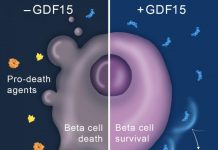January 2005 - Cells have protein associated with embryonic development, limb regeneration
A year ago, Massachusetts General Hospital (MGH) researchers discovered that the spleen might be a source of adult stem cells that could regenerate the insulin-producing islets of the pancreas. In a follow-up to that unexpected finding, members of the same team now report that these potential adult stem cells produce a protein previously believed to be present only during the embryonic development of mammals.
The finding both supports the existence of these splenic stem cells and also suggests they may be able to produce an even greater variety of tissues. The report appears in the January 19 issue of SAGE KE (http://sageke.sciencemag.org ), an online resource on the science of aging from the publishers of the journal Science.
"There may be a previously undiscovered pocket of primitive stem cells in the spleen that are important for healing several types of damage or injury," says Denise Faustman, MD, PhD, director of the MGH Immunobiology Laboratory and senior author of the SAGE KE report. "If so, these cells could have much broader therapeutic applications than suggested by our earlier work."
In 2001 Faustman's team found that a treatment designed to address the autoimmune reaction underlying type 1 diabetes actually cured the disease in diabetic mice. Late in 2003 they reported the mechanism behind the earlier discovery: cells from the spleens of donor mice � intended to train the diabetic animals' immune systems not to attack islet cells � were actually producing new islets. The result suggested that the adult spleen � previously regarded as playing a fairly minor role in regenerative medicine � might contain a population of potential islet stem cells.
In their pursuit of that finding, the MGH researchers investigated the possible presence of a protein called Hox11 in these cells. In mammals, Hox11 is a controller of key steps in embryonic development � including the formation of the spleen � but it was not known to be present in adults under normal circumstances. In some other animals, however, the protein has an intriguing function: when creatures like newts regenerate a lost limb or tail, production of Hox11 is radically increased.
Continue Reading Below ↓↓↓
As reported in their SAGE KE article, the MGH team did find that Hox11 was produced in the spleens of adult mice by the same cells that regenerated the islets in the earlier study. They also found that these cells did not produce a protein known to be associated with a cellular commitment to develop into a particular type of tissue. Without that commitment, the splenic cells may be able to differentiate into a wider variety of cells than can adult stem cells from bone marrow, which do not produce Hox11.
The researchers also note that the spleen develops from embryonic tissue that is known not only to generate precursors to many types of blood cells, a function shared by the bone marrow, but potentially to form such diverse organs as the small intestine, uterus, vascular system and lung. They theorize that a pocket of these uncommitted cells might remain in the spleen though adulthood. In addition to regeneration of islets, these cells might also produce bone cells � suggested by findings from other researchers � or potentially even cells of the nervous system, development of which depends on the correct production of Hox11.
"We know that if you have a major loss of blood, the spleen is turned on to supplement the bone marrow in replenishing your blood supply. We may find that the spleen kicks in to help with many more biological emergencies. What has been considered a practically unnecessary organ may actually provide critical healing cells," says Faustman, an associate professor of Medicine at Harvard Medical School.
She adds, "This data also shows the kind of payback that can come from studies of lower animals like newts and sponges. Combining the knowledge of Hox11's role in those animals with what we'd found about islet cell regeneration in mice helped us find this previously unknown example of normal, controlled Hox11 expression in an adult mammal."
Co-authors of the SAGE KE report are first author Shohta Kodama, MD, PhD, of the MGH Immunobiology Laboratory, and Miriam Davis, PhD, of George Washington University. The group's research is supported by grants from the Iacocca Foundation. Founder Lee Iacocca is also spearheading an effort to raise money for a clinical trial of the islet-regeneration technique in human patients. For more information about this program, go to http://www.joinleenow.org.
Source: Massachusetts General Hospital









